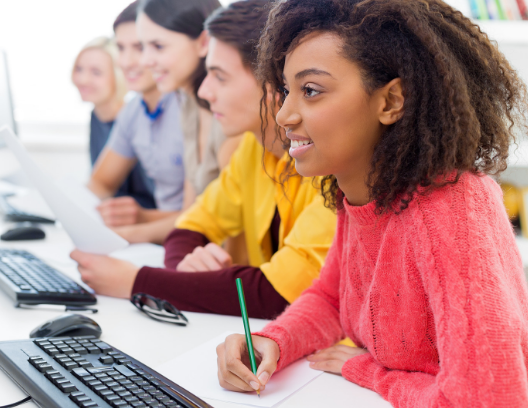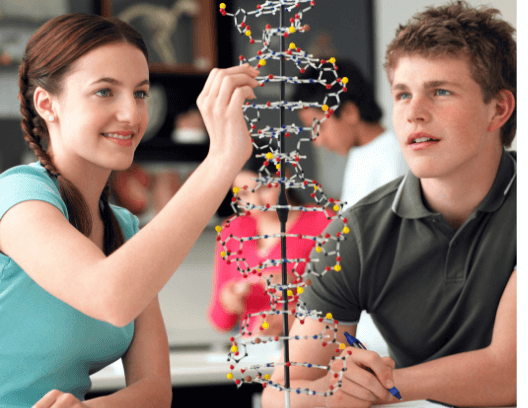Back to Project Based Learning Blogs
By: Andrea Behling, High School PBL Facilitator
Columbus Signature Academy New Tech High School
Columbus, IN
In a 2018 survey of business executives and hiring managers conducted by the Association of American Colleges & Universities, researchers identified the skills they most looked for when vetting potential employees. According to the key findings from this study, the top five intellectual and practical skills that employers and hiring managers seek in candidates are oral communication, teamwork skills with diverse groups, written communication, critical thinking and analytic reasoning, and complex problem solving. As educators, it is our job to prepare students for the “real world” once they leave the K-12 system. So how do we begin to shoulder the responsibility of preparing our students for this world on top of the state standards, test prep, and all of our other duties? The answer lies within the framework of project-based learning (PBL).
One misconception about these employability skills is that they are additional needs to address -- new standards that we are now expected to teach our students on top of some already incredibly full curricula. However, using project-based learning creates a framework and opportunity for students to build these skills through their work in the classroom. Where do these skills show up in a project?
1. Oral Communication
The ability to speak articulately and with confidence and clarity was the top skill identified by both business executives and hiring managers. Oral communication is also a skill that is inherently present in high-quality PBL. Within a project, students are required to communicate with their group members in order to create high quality products. This communication comes with group work, but also group management and accountability within groups (which I will discuss next ). Any opportunity to work with a community partner bolsters oral communication skills as the students learn how to communicate effectively with adults. While a panel or evaluator of a final product is a great opportunity to utilize a community partner and get your students developing oral communication skills, they can also be used as experts throughout the project to scaffold oral communication for your students in a lower stakes environment. Because of the various ways students can interact with stakeholders outside of the school throughout a project, students with PBL backgrounds leave school with a leg up in this skillset. Community partners that come into my classroom are often amazed that 16 year old juniors can be so articulate, but they gained that skill by going through the PBL process!
2. Teamwork skills with diverse groups
Another skill inherent in PBL is teamwork. Because so many projects are housed in a group setting, students must develop collaborative skills to find success in these groups. While education theory is moving best practice in the direction of more collaborative group work, the traditional school environment does not provide nearly as much opportunity as the PBL framework. However, as a PBL educator it is important to note that putting students into groups does not breed collaboration. These skills must be scaffolded and developed. To do this, begin utilizing tools such as group contracts, facilitator led check ins, and conflict management procedures to allow students to work through the group process. I often tell my students that while everyone has responsibility to the group, collaboration is not a jigsaw puzzle in which four individual pieces of work come together as a whole. Rather, collaboration is a process in which students must hold themselves and each other accountable to the standard of the project to create high quality products. Because students need to build these skills throughout their time in the PBL classroom, teachers must help facilitate the development of such skills. Use group work time to check in to every group, review their group contracts, and help them develop a system of accountability that works for them.
There is also strategy in how we group our students to create a relational dynamic that is going to push them. Every classroom is different and at the end of the day, you know your students. But in order to make sure your students can collaborate with all different kinds of people, be intentional about how you structure your groups. Do you have a few strong minded leaders in your class? Try putting them in a group together for a project. Help them have tough conversations when their strong ideas go in two (or more!) different directions. Conversely, you might have some students that often get pulled along in a project by stronger-willed students. Group a few of those students together, and help them foster their own leadership and creativity. Not only will all students end up with a more rounded skill-set in general, but through different grouping techniques, they will have the opportunity to work with a variety of different learners which will strengthen their collaboration skills for the future.
3. Written Communication
While writing and literacy are important components of most classrooms, I would argue that this is one of the employability skills that is not necessarily inherent in PBL. But it should be! In my classes, I make sure that every project I facilitate has some sort of written component. In order to help students develop the ability to write in different scenarios, I try to include a variety of writing assignments throughout the year. Are students studying war and conflict? Environmental change? Statistical data such as that which is provided in the census? Have them write a letter to a representative advocating for some type of policy change. Do they need to become an expert in a specific topic before they are able to create their final product? Have students write an informative research paper on their topic. Will they be contacting community partners throughout the project? Require a script or email template to be approved before any contact can be made. There is an opportunity for written communication in any product that your students can create within a project.
4. Critical thinking and analytic reasoning
One of the critical components of PBL is the authenticity that gives purpose to the content for student learning (for more on this idea, check out Joe Steele’s recent post on the topic of authenticity). Sometimes this connection is not the most direct. As a teacher, I can see a clear connection between the development of early river civilizations and the history of our own community. So how do I get my students to see this connection? The answer is critical thinking. In my social studies classroom, you will often find students taking a pause to do a written reflection of the content we are studying within the context of the project. For example, my World History students recently completed a project in which they hosted a clothing and canned food drive to benefit our community, taking inspiration from social movements that have changed the world such as the Protestant Reformation, the Renaissance, and the Scientific Revolution. After our workshop on Martin Luther, the Protestant Reformation, and the Catholic Church’s response, students completed this reflection assignment:
“Outline the issues and goals of the Protestant Reformation. What do you think made this movement so successful, or not successful? What can we learn from this movement and use to start and maintain our own movements?”
Although it was a brief assignment, it pushed my students to use critical thinking skills to make the connection between events from hundreds of years ago to their own work today. Reflection is another essential part of PBL, and through intentional reflection questions, we can push our students to think critically about their own learning and its context within the world today.
5. Complex problem solving
At its core, the goal of PBL is for students to address real world questions and answer them using research and inquiry. By the very nature of quality PBL, students are exploring complex problems and using all resources at their disposal to answer that question. The very first project my US History students embark on addresses the driving question, “Why do we believe what we believe?” They explore the development of propaganda throughout history and evaluate its uses and impact during different time periods. They then analyze the different strategies used in well-known and successful historical propaganda posters to appeal to a common audience and the effectiveness of different marketing strategies to create their own piece of “propaganda.” Throughout this entire process, they are constantly thinking critically and using inquiry to solve the problem at hand. While the original question is hard (arguably impossible) to answer, through their own questioning, research, and problem solving, they are able to craft a feasible answer to this question and apply it to their own product. One quick tip for PBL teachers is to craft a driving question for every project that requires this type of complex problem solving to help your students build this skill.
The basis of PBL is real-world application. We are always striving to eliminate the dreaded question, “When will I ever use this in the real world?” Integrating 21st century skills into your projects will not only increase engagement and authenticity, but will also make sure your students are prepared for the real world that awaits them outside of the walls of school.
Andrea Behling is a social studies facilitator at CSA New Tech, a project-based learning school in Columbus, IN. She has been facilitating in a PBL classroom for four years and also facilitates PBL workshops for Magnify Learning during the summer. Her favorite part of PBL is hearing her students reflect on the meaningful work they do and the connections they make between history and their own lives.
SIGN UP TO RECEIVE OUR PROJECT BASED LEARNING BLOGS & RESOURCES!





